SOUTHERN BELLES—MICHA’S VINEYARD, ANDY & MISHA WILKINSON. We’ve taken a couple of days out to write up some more of the travels as we are getting a lot of really good stuff backing up – too much visiting and not enough reporting!! Having looked at all things ‘Hayden’ last time round, before we look at all things ‘Misha’. For this one can I just have a small rave about the countryside and the feel of New Zealand.

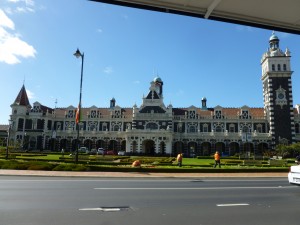 We have both decided that the people are so open and friendly, yes even Brian is chatting to people he has never met before and is unlikely to meet again! Just standing in a queue or in passing on the street a total stranger will say “enjoying the day” or “how’s it going”, they are genuinely curious and interested. Dunedin is rooted firmly in Victoriana, mainly in the glorious buildings enabled financially as a result of the Gold Rush! The Boys school on the hill (see photo taken from our hotel terrace) and the Knox Church and of course the railway station. We dined with Hayden at the top of Maori Hill and walked back down the steepest hill that claims to be part of a civilised town I have ever seen! Just to get back to the hotel in the centre of town, a disaster for the knees!
We have both decided that the people are so open and friendly, yes even Brian is chatting to people he has never met before and is unlikely to meet again! Just standing in a queue or in passing on the street a total stranger will say “enjoying the day” or “how’s it going”, they are genuinely curious and interested. Dunedin is rooted firmly in Victoriana, mainly in the glorious buildings enabled financially as a result of the Gold Rush! The Boys school on the hill (see photo taken from our hotel terrace) and the Knox Church and of course the railway station. We dined with Hayden at the top of Maori Hill and walked back down the steepest hill that claims to be part of a civilised town I have ever seen! Just to get back to the hotel in the centre of town, a disaster for the knees!
 The drive up to Alexandra is spectacular with mountains on all sides crowding into the road and even in this late
The drive up to Alexandra is spectacular with mountains on all sides crowding into the road and even in this late 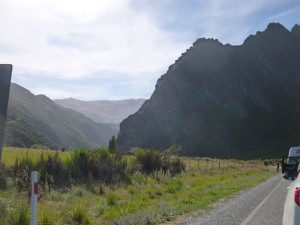 summer, one that will be famous for it’s drought at that, with snow still evident on the top peaks of the Old Man Range. In one place we were stopped as the cliff was in danger of falling on the road so they were busily blasting it before it fell whilst we all sat waiting in our cars for 20 minutes! Still better it should fall on the road than on us, as you can from the picture on the right it is a rather steep slope!
summer, one that will be famous for it’s drought at that, with snow still evident on the top peaks of the Old Man Range. In one place we were stopped as the cliff was in danger of falling on the road so they were busily blasting it before it fell whilst we all sat waiting in our cars for 20 minutes! Still better it should fall on the road than on us, as you can from the picture on the right it is a rather steep slope!
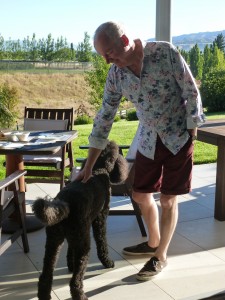 Onwards and upwards to Misha’s Vineyard (MV), another ‘Bendigo’ site just over the ridge from Hayden’s place along a track that is goat friendly, just, and clearly another reason they all have 4×4 vehicles. We deliberately left our car at Andy and Misha Wilkinson’s house first, as Andy had agreed to meet at his vineyard and show both us and Hayden around. As we left the car Brian met a most important member of the family, his new best friend, a wonderful black standard poodle named ‘Bogard’, called that because, as in Misha’s words “he is tall dark and handsome”.
Onwards and upwards to Misha’s Vineyard (MV), another ‘Bendigo’ site just over the ridge from Hayden’s place along a track that is goat friendly, just, and clearly another reason they all have 4×4 vehicles. We deliberately left our car at Andy and Misha Wilkinson’s house first, as Andy had agreed to meet at his vineyard and show both us and Hayden around. As we left the car Brian met a most important member of the family, his new best friend, a wonderful black standard poodle named ‘Bogard’, called that because, as in Misha’s words “he is tall dark and handsome”.
To put the Central Otago area into perspective, according to ‘New Zealand Wines’ official figures, NZ produces slightly less than 1% of the world’s production of which 2.4% is from Central Otago. What it fails to produce in quantity it more than makes up for with quality as MV more than supports! However Andy did say that one of the bigger companies have just bought a vineyard and winery close to Misha’s and ‘streamlined’ the methods of production to the extent that the original winemaker had sought alternative employment, now where have we heard that before! New Zealand Wines says of the area “The world’s southernmost wine region and the country’s highest, in this semi-continental climate, frosts are an accepted and planned for hazard, however the marked diurnal variation, high sunshine and short, hot summers provide an eloquent, if brutal, landscape for vines: site selection is everything. Dry autumns and overall low humidity are significant assets, helping to coax both amazing purity and complexity”.
We were particularly interested in the highlighted phrase above as it echoed exactly what both Andy and Hayden had said about their own plots, both very different but both selected for their individuality with the foresight to see their potential. Very different sites, Canyon being high and remote and in a small alluvial valley whilst Misha’s was chosen for its rocky terroir and its very close proximity to Lake Dunstan from where it draws its water, which is another story! In fact everything about this vineyard is a good story, perfect fodder for Odd Bottle fans, we have always said about City Beverage customers, they may not remember the name of the wine but they will remember the story that goes with it! The site was first selected with the aid of Robin Dicey a South African viticulturist, a great Central Otago fan from back in the 1970’s with hundreds of hectares of planted vines to his credit. When they first saw it, the 4×4 had difficulty getting at it, covered in rocks ranging from sofa size to fist size and Manuka bushes that, whilst fine for bees, are not easy to take up when planting a vineyard! The land is W. N.W. facing and so benefits very well from maximum summer sun which stores heat (Chateauneuf like) and slowly releases during the very cold nights.
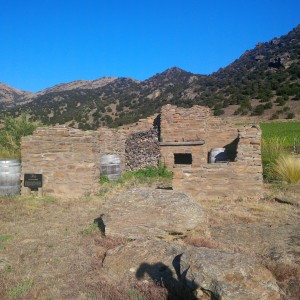 Back to stories again, this was originally ‘gold-mine’ territory and was prospected by a group of Chinese diggers who gained title to the land including the ‘Gully’ down which the water would run and which still has small dams created over 120 years ago. Misha was telling us that they met a local man of Chinese extraction whose ancestor had worked the land exactly here and had spoken to him about it as a child. This, and their love of Asia gave Andy and Misha the cue to create ‘Ah Foo’s’ House in the ‘Top Block’ of Misha’s Vineyard with the assistance of stonemason Trevor Kitto a local from Alexandra, and further developed in 2009 with the help of the stonemason students of the Otago Polytechnic in Cromwell. The ‘ruin’ is in the style and uses similar construction methods to remains found in the Bendigo area of several houses contemporary to the period. So convincing has the ‘legend’ become that Misha has calls from all over the world asking for more detail. Just goes to show the power of a good story!
Back to stories again, this was originally ‘gold-mine’ territory and was prospected by a group of Chinese diggers who gained title to the land including the ‘Gully’ down which the water would run and which still has small dams created over 120 years ago. Misha was telling us that they met a local man of Chinese extraction whose ancestor had worked the land exactly here and had spoken to him about it as a child. This, and their love of Asia gave Andy and Misha the cue to create ‘Ah Foo’s’ House in the ‘Top Block’ of Misha’s Vineyard with the assistance of stonemason Trevor Kitto a local from Alexandra, and further developed in 2009 with the help of the stonemason students of the Otago Polytechnic in Cromwell. The ‘ruin’ is in the style and uses similar construction methods to remains found in the Bendigo area of several houses contemporary to the period. So convincing has the ‘legend’ become that Misha has calls from all over the world asking for more detail. Just goes to show the power of a good story!
It is the original deed dated 1922 that gave them the key to the vines surviving on this arid site, the mining deed gave the land owners  (the miners) the right to draw water from the River Clutha. When Lake Dunstan was created by damming the Clutha that was not changed, thus the owners, now Andy and Misha, have the right to draw water from 200ft down in the lake for their vineyard! The steepness of the slope, it is not called the ‘ski slope’ for nothing, and the aspect of the site both contribute to its 99% frost free status, as the cold air is always on the move, rarely settles and is partially tempered by the lakes heat retention.
(the miners) the right to draw water from the River Clutha. When Lake Dunstan was created by damming the Clutha that was not changed, thus the owners, now Andy and Misha, have the right to draw water from 200ft down in the lake for their vineyard! The steepness of the slope, it is not called the ‘ski slope’ for nothing, and the aspect of the site both contribute to its 99% frost free status, as the cold air is always on the move, rarely settles and is partially tempered by the lakes heat retention.
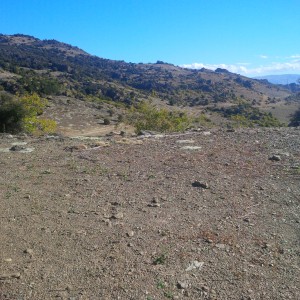 There is more; again largely due to the empathy that the couple feel for Oriental tradition and beliefs – having lived in Singapore for 13yrs. Feng Shui, which means “”Wind-Water”, and is the ancient Oriental art of studying the topography and understanding how the mountains, rivers, and valleys have been shaped by the wind and water that flow through them. The vineyard is located in a most auspicious feng shui ‘armchair’ or ‘horseshoe’ position with the high Dunstan Ranges (see left) at the back offering support and protection, lower hills flanking each side of the vineyard, a lake in front providing essential water and energy for the vines, and an orientation that maximizes the long afternoon sun. The graphic here also shows the rocks which are being constantly removed only to be followed by more as the earth breathes. We know this having helped clear 6 acres of flint down in Kent to grass over and then spending the next ten years still collecting rocks in just the same way.
There is more; again largely due to the empathy that the couple feel for Oriental tradition and beliefs – having lived in Singapore for 13yrs. Feng Shui, which means “”Wind-Water”, and is the ancient Oriental art of studying the topography and understanding how the mountains, rivers, and valleys have been shaped by the wind and water that flow through them. The vineyard is located in a most auspicious feng shui ‘armchair’ or ‘horseshoe’ position with the high Dunstan Ranges (see left) at the back offering support and protection, lower hills flanking each side of the vineyard, a lake in front providing essential water and energy for the vines, and an orientation that maximizes the long afternoon sun. The graphic here also shows the rocks which are being constantly removed only to be followed by more as the earth breathes. We know this having helped clear 6 acres of flint down in Kent to grass over and then spending the next ten years still collecting rocks in just the same way.
Finally, and again rooted in Oriental belief is the Number 8, one of, if not the luckiest number for the Chinese people. 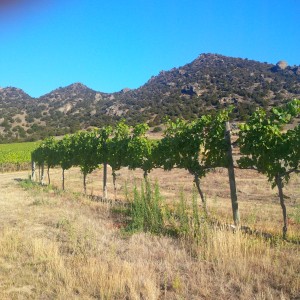 The vineyard is on State Highway 8, exactly 8k from Cromwell, the site was originally called Sheep Run 238 and there are 8 clones of Pinot Noir planted in two row directions – 288º on the slopes and lakefront terrace, and 341º (adding up to 8) on the higher terraces. The first commercial vintage was 2008 and there are 8 wines in the portfolio. We went up to the site where the first 8 vines were planted – underneath each one is an old Chinese gold coin brought by the couple from China so that in their words they “symbolically return the ‘old gold’ to the ground and bring luck for the ‘new gold”. These are called the ‘Lucky 8’ vines and long may they continue to work for such an enterprising couple.
The vineyard is on State Highway 8, exactly 8k from Cromwell, the site was originally called Sheep Run 238 and there are 8 clones of Pinot Noir planted in two row directions – 288º on the slopes and lakefront terrace, and 341º (adding up to 8) on the higher terraces. The first commercial vintage was 2008 and there are 8 wines in the portfolio. We went up to the site where the first 8 vines were planted – underneath each one is an old Chinese gold coin brought by the couple from China so that in their words they “symbolically return the ‘old gold’ to the ground and bring luck for the ‘new gold”. These are called the ‘Lucky 8’ vines and long may they continue to work for such an enterprising couple.
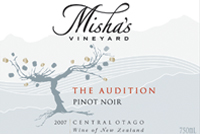 The single vine on the label represents the care and attention that goes into each of the vines so that they can produce ‘gold’ – symbolically 8 bunches of gold foil. At this stage I should say that we first met Misha and Andy through PLB and have been carrying the ‘Limelight Riesling’ and the ‘High Note’ Pinot Noir up until the sale, hoping that Amathus are carrying them on! The naming of each of the wines is a reflection on Misha’s background, her mother was the Opera singer, Gloria McDonall and she herself trained as a ballerina until, at 17, she became too tall; so the decision to give each of the wines a theatrical themed name was an easy one especially as they have been carefully chosen to reflect the wine itself. I particularly love the fact that the very first 100 cases of Pinot Noir from the first harvest were called ‘The Audition’!
The single vine on the label represents the care and attention that goes into each of the vines so that they can produce ‘gold’ – symbolically 8 bunches of gold foil. At this stage I should say that we first met Misha and Andy through PLB and have been carrying the ‘Limelight Riesling’ and the ‘High Note’ Pinot Noir up until the sale, hoping that Amathus are carrying them on! The naming of each of the wines is a reflection on Misha’s background, her mother was the Opera singer, Gloria McDonall and she herself trained as a ballerina until, at 17, she became too tall; so the decision to give each of the wines a theatrical themed name was an easy one especially as they have been carefully chosen to reflect the wine itself. I particularly love the fact that the very first 100 cases of Pinot Noir from the first harvest were called ‘The Audition’!
Andy and Misha freely admit that they started off with no viticultural or vinification experience, although they are quickly gaining both, what they did have, which has proven invaluable, is that they are very clever team builders and have a great group around them.
Olly Masters, who we managed to miss by a day at every destination we had in common the length of NZ, is a very distinguished winemaker having worked very closely with Clive Paton at Ata Rangi. He makes the MV wines at Maude Winery on the edge of Lake Wanaka a few miles North with the help and cooperation of Dan and Sarah-Kate Dineen, two other very notable winemakers.![explore_pic21[1]](http://oddbottle.eu/wp-content/uploads/2015/02/explore_pic211.jpg)
Robin Dicey the consultant Viticulturist works closely with Michelle Dacombe the very experienced Vineyard Manager and Aaron and Sue who are out there pruning to make sure that the fruit that is just the best quality possible when it leaves the vineyard. It is Robin who came up with the idea of netting each fourth row (see picture) to offset the more extreme winds that funnel down the valley.
They have also not forgotten to create a first class office team with Alistair, Jill and Tim to make sure that when it is made it is efficiently sold and delivered. Bogart assists with whatever is thrown at him, usually his ball!
Having tasted the entire range in UK, we were very happy over dinner to just taste some more recent vintages as well as having the privilege of tasting one of the very few bottles left of the 2008 their very first production of Gewürztraminer. I have inserted Olly’s ‘winemaking summary’ and then commented as he knows best and why re-invent the wheel! We started with an unusual wine, Otago Sauvignon Blanc, a revelation both here and later at Amisfield!
‘The Starlet’-Central Otago Sauvignon Blanc 2012 — Described as “fresh and fruity and best enjoyed young” another appropriate nomenclature! Cute name but serious wine, handpicked and whole bunch pressed, the free run and early press portion was settled, racked, and cool fermented in s/steel. In order to give more texture to the palate, a portion (the notes say 11%-I noted 30%) was allowed to go through spontaneous (wild yeast) ferment in older oak barrels. The result is a very good, if highly individual, S/Blanc, lots of tropical fruits on both aromas and palate, more herb than cut grass but fresh herbs not dried, a real full firm texture on the palate (from the oak) but no apparent oak aromas or taste. Big, juicy’ fruit and a lovely lingering texture on the finish, if this is the new Otago S/Blanc style, to continue the theatrical analogy, I for one wish it a very long run!
‘Limelight’- Central Otago Riesling 2013 – At this stage I should declare an interest in that I do think that this is one of the best New World Rieslings I have tasted! From the very first tasting with Misha at the shop this just ‘struck a chord’ with me as getting to the core of what Riesling is all about. The top note is definitely lime both on palate and aromas, not unlike some very good German houses I can think of, with a low alcohol for the new world at 11.5 it hides it’s 31gms of residual sugar very well indeed with a clean fresh acidity that leaves the palate fresh. This has a remarkable ‘zingy’ quality that gives it an appeal that I find difficult to resist as an aperitif or just to drink as a refreshing glass of wine, we drank it as an aperitif at Misha’s on the terrace watching the dying sun disappear over the mountain, it really is a hard life this wine reporting! Just for the record this is the winemaking: “A classic medium/dry Central Otago style with all the fruit being hand-picked and whole bunch pressed. The initial free run juice (76%) was then racked, inoculated and cool fermented (15-17 C) in stainless steel to retain varietal purity. As the aim with the wine is to produce a delicate style where acidity is balanced by natural sugar, the ferment was stopped early by chilling, retaining 28g/l sugar and therefore also a lower alcohol. The remaining juice was allowed to ferment naturally in older French oak at warmer temperatures (18-20 C) to enhance the mineral and flint characters which also balance the wine’s sweetness”.
‘The Gallery’ Central Otago Gewürztraminer (GW) 2008 — This was a rare treat as this is one of the few bottles left of the MV first GW vintage, all the more so because I had been pretty scathing about the GW 2012 that we tasted at the shop! In this trade you have to be big enough to drink your own words when you are mistaken and judging by this bottle I am happy to say I was! First the technical stuff! “With Gewürztraminer it is important to retain its distinct varietal characters, hence 60% of the whole bunch pressed juice was fermented at a cool temperature (<17°C) in s/steel. In order to build texture the remaining proportion (40%) was warm fermented with wild yeast in older French oak. Fermentation for a portion of the wine was stopped with a small amount of sweetness remaining in order to balance the wines natural acidity. Misha prepared a ‘mis en bouche’ that was for me the most perfect combination in itself and went with the GW beautifully! Water Chestnuts wrapped in Smokey Bacon and liberally dusted with herb garlic salt then grilled and served just as the bacon browns, a marriage made in heaven with what is a balanced GW with great varietal aromas and taste, well balanced acidity and a lovely clean finish. Better, I suspect, with food than without but then if you have Limelight you have the best of both worlds.
‘The High Note’ Central Otago Pinot Noir 2010 — An interesting comparison to Hayden’s P/N from just the other side of the hill, a real rapier and broadsword situation and all down to terroir! Technical summary: “Fruit was chilled overnight before crushing the next day typically in 3-5 tonne lots. The crushed fruit was cold soaked for 5-7 days after then allowed to warm as the natural yeast ferment took place. Cooling was used to ensure the ferments peaked below 32°C after which it was held warm (20°C) post ferment to allow ongoing tannin integration. After 23 days on skins the wines were pressed to tank and settled for 1-2 days before being racked to French oak (27% new, 300L barrels). Malolactic ferment took place in the following spring then it was then racked out of barrels and held in tank. It was then partially filtered prior to being bottled in December 2011”. The result is a P/N that is very much to my taste and reflects the rocky minerality of the terroir from which it originates. It delivers fruit in the form of blackberry and black raspberry, it has a steely quality to it, as it warms in the glass, subtle hints of farmyard and forest floor develop on the back palate, it is a truly elegant P/N and one that will definitely develop well in bottle, drinker or keeper depending on the style of P/N you like.
‘The Cadenza’ Late Harvest Gewürztraminer 2014 Central Otago —This we drank with baked locally grown white peaches which again was a perfect match with the wine. Technical summary: The late-harvest hand-picked fruit (approx. 20% botrytis infected) gently crushed and left to soak overnight to maximize flavours and sugar extraction from the desiccated fruit. Pressing was next day and the juice was settled clear and 100% tank fermented, cool fermented (15-17 C) with commercial yeast in order to retain varietal freshness. Ferment was then halted by chilling at the optimum residual sugar level (120 g/l). This will be exceptionally good, even in its youth it sat very well with the dessert, it is still quite tight on the aromas but on the palate has concentrated intensity of fruit and great balance of acidity and sugar, remarkable when you consider the residual sugar at 120g/l ! This is still very young for its profile and definitely to be bought and kept; good now, it will be superb with a bit of bottle age. This vineyard is small and very well run and producing some really excellent wines which are both drinking very well now and will also benefit from some bottle ageing. The wines are also typical of what Otago is all about and hopefully will remain, it would be sad to see the bigger companies come in and take away the real hands on, artisan feeling that you get with the region and its winemakers. Misha as you might imagine wearing her ‘marketing hat’ has created a great website where the full ‘Ah Foo’ story, which is very convincing, and a delight, can be read, as well as many other gems of information on the Misha vineyard look on: http://www.mishasvineyard.com. 
Last word to a rather puzzled Bogart looking for squeaky teddy, as they say in the theatre, “he’s behind you!”

Second time I discovered your website on Google. Great stuff.